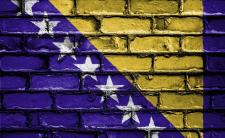The Republic of Bosnia and Herzegovina is situated on the Balkan Peninsula in southeastern Europe. It has approximately 26 kilometers of coastline to the Adriatic Sea. It is bordered to the north, west, and south by Croatia, to the east by Serbia and to the southeast by Montenegro. Sarajevo is the country’s capital and home to approximately 4 million persons.
Political system
Bosnia and Herzegovina is a presidential style parliamentary republic that is governed by a collegial Presidency consisting of one Croat, one Bosniac, and one Serb. It has a bi-cameral legislature consisting of the House of the People and the House of Representatives. Together, these chambers form the Parliamentary Assembly. The Constitutional Court is the country’s highest judicial body.
Constitutional history and development
Early constitutional development
The territory now occupied by Bosnia and Herzegovina was captured by Slavs, Serbs, and Croats in the sixth and seventh centuries. After the rule of the Ottoman Turks, which lasted until 1878 and the Austro-Hungarian Empire, the first constitution for Bosnia and Herzegovina was promulgated and first elections were held in 1910. The 1910 constitution explicitly mentioned Serbs, Croats and Muslims as the “native peoples”.
Following the end of World War I, and the defeat of Austria-Hungary, a Kingdom of Serbs, Croats and Slovenes was declared in the Balkans on 4 December 1918. In 1921, the so called Vidovdan constitution followed the agreement between the Muslim party and the Serbian radicals to keep Bosnia and Herzegovina a separate administrative unit in the new kingdom. This constitution, however, was annulled by King Alexander in 1929 and replaced by a new constitution in 1931. The name of the country was changed to Kingdom of Yugoslavia. The 1931 constitution provided for a parliament but ministers and other high officials were dependent on the king.
After World War II, the constitution of the Federal People’s Republic of Yugoslavia (later Socialist Federal Republic of Yugoslavia), was proposed and adopted under a communist regime on 31 January 1946. The constitution was largely based on the Soviet constitution of 1936 and created six republics whilst respecting five nationalities, namely Croats, Macedonians, Montenegrins, Serbs, and Slovenes. Muslims, however, were not mentioned. In 1952, 1963, and 1974, other socialist Yugoslav constitutions were adopted. Amongst the changes were the creation of a federal presidency of nine persons with six of the persons being from the republics and two from the autonomous provinces of Vojvodina and Kosovo. The head of Yugoslavia’s Communist Party and president for life at that time, Josip Brox, also known as Tito, was the ninth member of the presidency. By 1963 Muslims were listed in the Bosnian constitution alongside Serbs and Croats. The 1974 constitution, moreover, stipulated equal rights among all nationalities living in the territory.
Developments after the end of communism
Soon after Tito’s death in 1980, the Yugoslav federation began to collapse. On 1 March 1992, a referendum showed great support for Bosnian independence. However, independence was opposed by most Serbs, who feared to lose power and influence over the region. These frictions gave rise to the Bosnian war, which continued till the signing of The General Framework Agreement for Peace in Bosnia and Herzegovina, also known as the Dayton Agreement, in 1995. A High Representative of the International Community still has the authority to oversee the implementation of the Dayton Agreement.
The Constitution of 1995
As part of the Dayton Accords, the current constitution was signed in Paris on 14 December 1995 by three former presidents of countries who had been involved in the war, as well as several representatives of the international community. The constitution of 1995 emphasizes in its preamble the break with the communist past and contains sensitive provisions on ethnic representation in the country’s different institutions and bodies of government. It lists fifteen international human rights agreements that are to apply in Bosnia and Herzegovina and moreover provides for specific human rights and fundamental freedoms to all persons in the country, which cannot be abolished or eliminated through an amendment to the Constitution. A system of division of power is introduced, distributing power among the country’s geographic and ethnic entities, as well as between the three branches of government at state level. The country was subdivided in two entities: The Federation of Bosnia and Herzegovina (divided into 10 cantons) and the Republika Srpska. The entities have responsibilities in the field of taxation, except indirect taxation, business development, and general legislation. In 2000, the constitutional court decided a landmark case on the provisions of the entities’ constitutions regarding the “constituency” of peoples, obliging the two entities to amend their constitutions to guarantee the full equality of the country’s three “constituent peoples” (Bosniacs, Croats and Serbs) throughout its territory. Attempts to amend the constitution in 2006 have not been successful, although recommended and partly requested by the international community. On 16 June 2008, the European Union and Bosnia and Herzegovina signed the Stabilization and Association Agreement and the Interim Agreement on trade and trade-related issues.
The Executive
The constitution includes a collegial three-person presidency, consisting of one Bosniac, one Croat and one Serb, each of them serving for four years. The Bosniac and Croat members are directly elected from the territory of the Federation whilst the Serb member is elected from the territory of the Republika Srpska. Members of the presidency may be reelected once and are then ineligible for four years. A chair, who is selected by rotation or determined by the parliamentary assembly in case of no consensus, heads the presidency. However, decisions in the presidency shall be by consensus, otherwise by a majority of the members. If the decision is seen to be “destructive of a vital interest” the dissenting member may appeal it within three days. A two-thirds majority of the legislature from the dissenting member’s respective territory is then allowed to nullify the decision. According to paragraph 3 of Article V, the presidency is competent to conduct foreign policy; appoint ambassadors; negotiate, denounce and ratify treaties; execute parliamentary decisions, as well as propose an annual budget. In addition, the members of the presidency are given “civilian command authority over armed forces”. However, neither of the entities is allowed to use force against another entity without the consent of the government of the latter and of the presidency.
The chair of the council of ministers, nominated by the presidency, selects the other members of the council with the approval of the House of Representatives. Not more than two-thirds of the members shall be appointed from the territory of the Federation. The council’s task is to carry out “the policies and decisions of Bosnia and Herzegovina”. If a vote of no-confidence is passed by the parliamentary assembly, the council of ministers is required to resign.
The Legislature
The constitution provides for a bicameral parliament, comprising a lower chamber, the House of Representatives, and an upper chamber, the House of Peoples. It enjoys institutional autonomy, and has a moderate amount of power over the executive. The legislature enacts legislation in order to implement decisions of the presidency or to carry out its own duties under the constitution. Its competencies include the power to amend the constitution, approve international treaties and the annual budget, appoint members of the judiciary, grant amnesties and pardons and approve presidential declarations of war. Moreover, it is allowed to issue a vote of no-confidence against the council of ministers. The approval of both chambers is needed for all legislation. Similar to the decisions of the presidency, an act can be annulled if a majority of the respective members of parliament declares it to be “destructive of a vital interest” of the people. A joint commission, or under specific circumstances the constitutional court, has to resolve the dispute in case a majority of the members of parliament of another entity objects to the declaration.
The Judiciary
The constitutional court, a body of nine members, has original and final jurisdiction over all matters relating to the interpretation of the constitution. Four members are elected by the house of representatives of the Federation, two members by the Assembly of the Republika Srpska, and three members are designated by the president of the European Court of Human Rights (ECHR) after consultation with the presidency. The ECHR may not select judges who are citizens of Bosnia and Herzegovina or of any neighboring country. The first judges of the court were appointed for five years. Judges appointed thereafter, however, stay in office until the age of 70. The court is competent to hear appeals over issues under the constitution arising out of judgments of any other court. In addition, any court in Bosnia and Herzegovina may ask the court to review the constitutionality of laws, on whose validity its decision depends, with the constitution, with the European Convention for the Protection of Human Rights and Fundamental Freedoms and its Protocols, or with the laws of Bosnia and Herzegovina. The court is granted exclusive jurisdiction on disputes between entities or between the country and entities as well as on disputes between state’s institutions. The latter disputes may only be referred to the court by certain officials or bodies.
Constitutional and political challenges
-
Achieving a common vision for the country among Bosniacs, Croats and Serbs and developing genuine cross-ethnic cooperation whilst reducing the nationalist view on things.
-
Reducing the country’s dependence on international authority.
-
Reforming the inefficient structure of government established under the Dayton Agreement; currently, the country with a population of just under 4 million people counts two entities for three constituent peoples (Bosniac, Croats, Serbs); five presidents, four vice presidents, 13 prime ministers, 14 parliaments, 147 ministers and 700 members of parliament.
-
Strengthening the central structure at the expense of the entities of Bosnia and Herzegovina, e.g. conceding more decision-making powers to the council of ministers. At the national level, government competencies are limited; however, consensus to strengthen them is absent. In contrast, the entities operate virtually as separate countries and the administration structures cost are deemed unnecessary and too expensive.
-
Reforming both chambers of the parliament, reducing the powers of the tripartite presidency and reconsidering its system of rotation.
-
Improving the scrutiny of human rights.
-
Changing the electoral system which is based on nationalist parties and thus poses practical concerns for consensus democracy.
-
Changes put forward by the Venice Commission: Transfer of competencies from the entities to the state; reform of inefficient state legislative and executive structures; elimination of “prerogatives for ethnic or group rights”; strengthening citizens rights; clarification of the entities’ future relationship to the state
System of government
Timeline
| 1908 | Bosnia and Herzegovina annexed to Austria-Hungary. |
| 1910 | First constitution for Bosnia-Herzegovina is issued. |
| 1914 | World War I begins after Gavrilo Princip, a Bosnian-Serb student, assassinates the Austrian archduke Franz Ferdinand in Sarajevo. |
| 1918 | Austria-Hungary collapses at the end of the war. Bosnia and Herzegovina becomes part of the Kingdom of Serbs, Croats and Slovenes. |
| 1921 | The so called Vidovdan Constitution is adopted. |
| 1931 | New constitution issued under King Alexander I, establishing the Kingdom of Yugoslavia. |
| 1941 | Bosnia-Herzegovina annexed by Hitlerite Croatian puppet state. Thousands of Serbs, Jews and Gypsies are sent to the death camps. |
| 1945 | Bosnia and Herzegovina liberated. The country becomes a republic within the Yugoslav Socialist Federation ruled by Tito. |
| 1991 | First multi-party elections after the end of communism. |
| 1 March 1992 | Croat and Muslim nationalists outvote Serbs at independence referendum. War breaks out and Serbs assume control of over half the republic. |
| 1993 | Conflict breaks out between Muslims and Croats. |
| 1995 | UN safe haven of Srebrenica is overrun by Bosnian Serb forces under General Ratko Mladic. Thousands of Bosnian Muslim men and boys are massacred. |
| 14 December 1995 | Dayton peace accord signed in Paris, including the new fundamental law of Bosnia and Herzegovina. An international peacekeeping force is deployed. |
| 1996 | The International Criminal Tribunal for the former Yugoslavia begins work in The Hague. |
| 2004 | Nato hands over peacekeeping duties to a European Union-led force, EUFOR. |
| 2006 | International Court of Justice in The Hague begins hearings in genocide case brought by Bosnia and Herzegovina against Serbia and Montenegro. |
| 2006 | EU signs Stabilization and Association Agreement. |
| 2006 | Bosnia joins Nato's Partnership for Peace pre-membership programme. |
| 2007 | The International Court of Justice rules that the 1995 Srebrenica massacre constituted genocide, but clears Serbia of direct responsibility. |
| 2008 | Radovan Karadzic is arrested in Belgrade. |
| 2009 | Austrian diplomat Valentin Inzko takes over as High Representative. |
| 2009 | EU- and US-brokered talks aimed at pushing for constitutional reform fail. |
| 2010 | Bosnian Serb Republic passes law making it easier to hold referendums on national issues. This is seen as challenging to the international High Representative's authority and a move towards a referendum on independence. |
| 2011 | Serbian authorities arrest former Bosnian Serb military chief Ratko Mladic. |
Bibliography
- Balkan Investigative Reporting Network. Bosnia: Constitution Reform Setback. 2007. Web. 12 Jul 2011.
- British Broadcasting Corporation. Bosnia and Herzegovina Country Profile. 2011. Web. 12 Jul 2011.
- Bosniak history from the pre-Slavic roots to the modern age. 2009. Web. 18 Jul 2011.
- Constitution of Bosnia and Herzegovina.
- Central Intelligence Agency. The World Factbook: Bosnia and Herzegovina, 2011. Web. 11 Jul 2011.
- European Commission Enlargement. Bosnia and Herzegovina - Relations with the EU. Web. 12 Jul 2011.
- Fish, Steven M., Kroenig, Matthew. The Handbook of National Legislatures. 2009. Cambridge University Press.
- International Crisis Group Report No. 128. Implementing Equality: The “Constituent Peoples” Decision in Bosnia & Herzegovina. 16 April 2002. Sarajevo/Brussels.
- Stamselberg, Nadja. Down With the National Key Policy: In Search of a Cosmopolitan Reply to the Political Challenges of Nationalism and Ethnification in Bosnia and Herzegovina. Web. 19 Jul 2011.
- The History Place. Web. 11 Jul 2011.
- The United States Institute of Peace. Making Bosnia Work: Why EU Accession is Not Enough. 2008. Web. 12 Jul 2011.
- United States. Background Note: Bosnia and Herzegovina, 2011. Web. 11 Jul 2011.
| Branch | Hierarchy | Appointment | Powers | Removal |
|---|






Share this article